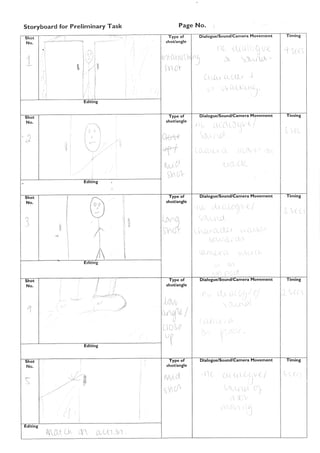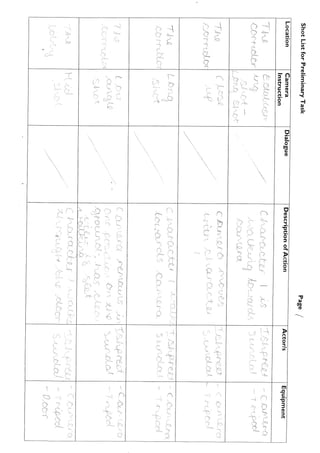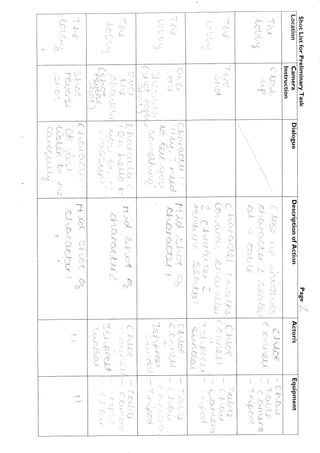1 of 6
Download to read offline






Ad
Recommended
Editing of Horror Movie
Editing of Horror MovieBryony Johnson
╠²
The document discusses various editing filters, fonts, and sound editing applied in a movie project. Filters like Luma Keyer, Prism, and Flipped were used to darken tones, signify different points of view, and add variation. Different font colors like red and darker red were tested alongside drop shadows to make the text more visible against the horror genre backdrop. Sound was also edited by fading it out at the end for a smoother transition.Draft Treatment for Horror Film
Draft Treatment for Horror FilmBryony Johnson
╠²
A vampire family seeks revenge on a small town in England for killing their ancestors 40 years ago. They plan to murder anyone who gets in their way by filming close-up shots of their fangs and killing victims in a dark forest. The film will explain the family's history through pictures and show current killings to avenge the wrongful execution of their relatives in 1970.Horror risk assessment
Horror risk assessmentBryony Johnson
╠²
The risk assessment document identifies hazards such as using a car, being alone in the forest, and going near a pond for a filming trip. It notes that students and drivers are at risk from the car, while students are at risk of getting separated, kidnapped, or hurt in the forest. The pond poses drowning, falling, and illness risks to students. Control measures like seat belts, sticking together, and not getting too close to water aim to reduce risks rated from high to low.Ident Storyboard
Ident StoryboardBryony Johnson
╠²
This storyboard document outlines 4 shots to be filmed for a project: a pan upwards shot, a ripple shot, a focus pull shot, and a fade to black shot. Each shot lists the type of shot or camera angle, any dialogue, sounds or camera movements, and the intended timing. The storyboard provides a visual plan and timeline for capturing the scenes.Texas Chainsaw Shot List
Texas Chainsaw Shot ListBryony Johnson
╠²
This 3 sentence summary provides an overview of the key elements and progression of the film opening for 'Texas Chainsaw' (2013):
The opening begins with studio logos and title cards against a dark red backdrop with ominous choir music, then introduces the setting of an abandoned house and garden. Scenes of a villain attacking victims with a mallet and dragging one away are intercut with identifying title cards for the actors. The opening concludes by introducing more actors and locations while escalating the violence, showing the villain attacking another victim with a chainsaw.Shotlist for horror film
Shotlist for horror filmBryony Johnson
╠²
This shot list details the camera shots needed for a horror film set in the woods. It includes 18 shots ranging from establishing shots, close-ups, tracking shots, and shots from different angles. The shots will show a victim, played by Bryony, walking alone in the woods while being stalked by a vampire, played by Hasnat. The shots will capture the victim's increasing unease and eventual attack by the vampire. Equipment needed includes cameras, tripods, and a phone.InDesign 1
InDesign 1Bryony Johnson
╠²
The document describes steps taken to layout and design a page in InDesign, including:
- Setting the page size and adding columns
- Adjusting bleed, slug, borders, and columns
- Creating and formatting shapes and text boxes
- Inserting and fitting images
- Arranging layers and exporting the final design as an InDesign file or JPEG imageMusic Video Risk Assessment
Music Video Risk AssessmentBryony Johnson
╠²
1) The document assesses various hazards on a film set, the risks they pose, who is affected, and control measures. Lighting poses the highest risk, as it could fall and injure someone or damage eyes if too bright, and wires could cause tripping. Control measures include not overbrightening lights, clearing wires, and care near wires.
2) A green screen poses medium risk as actors could trip, controlled by care and avoiding fast movement.
3) Glow sticks pose lowest risk as they could burst and are toxic, controlled by avoiding sharp objects.Filimng schedule
Filimng scheduleBryony Johnson
╠²
This document contains a shooting schedule for a music video that includes 76 shots. It lists the description of each shot, characters and location, estimated time to film, and any necessary props. Shots will feature Rumena lip syncing and dancing as Ariana Grande in various locations like a green screen, wallpaper, canteen, and street. Other actors will play Grande's friends and a crush. Filming is estimated to take around 4 hours total and will require equipment like a camera, tripod, lighting, and props like an iPod, balloons, and glow sticks to play music and set the party scene.Shot list
Shot listBryony Johnson
╠²
This document contains a shot list for a music video featuring the song "All My Love" by Ariana Grande. It includes 76 shots with descriptions of the camera angle, location, lyrics covered in each shot, and brief descriptions of the actions and actors involved. The shots cover a variety of indoor and outdoor locations and include scenes of the lead actress lip syncing lyrics alone and with friends, arriving at and enjoying a party, interacting with a love interest, and dancing with others at the party.Shotty
ShottyBryony Johnson
╠²
The document provides a shot list for filming a music video. It includes 64 shots with descriptions of the camera angle, location, lyrics covered, actions, actors, and equipment for each shot. The shots include both indoor and outdoor locations and cover the singer and backup dancers performing different parts of the song through singing and dancing. Equipment includes cameras, tripods, green screens, props, and other standard film production gear.Shotlistttttt
ShotlisttttttBryony Johnson
╠²
This shot list contains 14 shots for filming a music video. It includes the location, camera instructions, song lyrics, description of actions, actors, and equipment for each shot. The shots include close-ups and mid shots of the lead singer in different locations like the bedroom, oracy room, science lab, and house. The shots will showcase the singer alone and with others, incorporating props like polaroid pictures, balloons, beakers, and a punch bowl. The goal is to film the scenes to create a music video for the song describing partying and celebrating with friends.Magazine Advert Research
Magazine Advert ResearchBryony Johnson
╠²
The advertisement features the same album cover art and positioning of title and artist name as the actual album. It lists the album title and one of its singles, describing the single as the "#1 international smash" to encourage audience purchase. The ad also includes logos and websites for the artist, record label, and Amazon to direct buyers where they can obtain the album.Final Treatment
Final TreatmentBryony Johnson
╠²
The music video outline proposes showing the lead singer Ariana Grande at a restaurant with friends where she sees her crush. They break into a dance at the chorus showing her happiness. Later at a party, the singer confesses her love for her crush at the bridge before everyone is shown dancing together at the end with the singer and her crush now together. The resources needed include actors to play the singer, crush, and friends along with background partygoers. Props include a phone, balloons, and glow sticks. Settings are a restaurant, street, and party location. Technical resources are a camera and tripod.Risk Assessment - Horror Film
Risk Assessment - Horror FilmBryony Johnson
╠²
The risk assessment document identifies hazards for a school trip to film at Bentley Priory, including students getting run over by a coach, separated from the group in the forest, or hurt near a pond. It lists controls like wearing seatbelts on the coach, sticking together in the forest, and not getting too close to the water. The biggest risks are being run over and getting separated from the group.Horror risk assessment
Horror risk assessmentBryony Johnson
╠²
The risk assessment document identifies hazards for a school trip to film at Bentley Priory, including students getting run over by a coach, separated from the group in the forest, or hurt near a pond. It lists controls like wearing seatbelts on the coach, sticking together in the forest, and not getting too close to the water. The biggest risks are being run over and getting separated from the group.Horror risk assessment
Horror risk assessmentBryony Johnson
╠²
The risk assessment document identifies hazards for a school trip to film at Bentley Priory, including students getting run over by a coach, separated from the group in the forest, or hurt near a pond. It lists controls like wearing seatbelts on the coach, sticking together in the forest, and not getting too close to the water. The biggest risks are being run over and getting separated from the group.Draft treatment
Draft treatmentBryony Johnson
╠²
The music video treatment outlines a narrative where the lead singer sees a boy she likes at a diner and later attends a party with her friends. It will include choreographed dancing at the diner and party scenes. Resources needed are actors to play the singer, her friends, the boy and partygoers, as well as a diner, street, and party location and camera equipment. The American diner setting relates to the artist's American background and genre conventions, while the street and party were popular choices from audience research.Frame Analysis
Frame AnalysisBryony Johnson
╠²
This document analyzes and compares scenes, conventions, and motifs from Ariana Grande's music video for "Baby I" to other pop and R&B music videos. It discusses how the mid shot of Grande emphasizes her likable persona. Bright colors and graffiti in the background reference 90s R&B videos. Close ups show Grande's emotions and mouthing lyrics while on the phone, a common convention. Long shots present Grande as a style icon and draw attention through techniques like Laura Mulvey's male gaze. Party scenes are conventional despite not relating to lyrics. Choreography, lighting, hair styles, and hand gestures are also repeated across Grande's videos.More Related Content
More from Bryony Johnson (11)
Filimng schedule
Filimng scheduleBryony Johnson
╠²
This document contains a shooting schedule for a music video that includes 76 shots. It lists the description of each shot, characters and location, estimated time to film, and any necessary props. Shots will feature Rumena lip syncing and dancing as Ariana Grande in various locations like a green screen, wallpaper, canteen, and street. Other actors will play Grande's friends and a crush. Filming is estimated to take around 4 hours total and will require equipment like a camera, tripod, lighting, and props like an iPod, balloons, and glow sticks to play music and set the party scene.Shot list
Shot listBryony Johnson
╠²
This document contains a shot list for a music video featuring the song "All My Love" by Ariana Grande. It includes 76 shots with descriptions of the camera angle, location, lyrics covered in each shot, and brief descriptions of the actions and actors involved. The shots cover a variety of indoor and outdoor locations and include scenes of the lead actress lip syncing lyrics alone and with friends, arriving at and enjoying a party, interacting with a love interest, and dancing with others at the party.Shotty
ShottyBryony Johnson
╠²
The document provides a shot list for filming a music video. It includes 64 shots with descriptions of the camera angle, location, lyrics covered, actions, actors, and equipment for each shot. The shots include both indoor and outdoor locations and cover the singer and backup dancers performing different parts of the song through singing and dancing. Equipment includes cameras, tripods, green screens, props, and other standard film production gear.Shotlistttttt
ShotlisttttttBryony Johnson
╠²
This shot list contains 14 shots for filming a music video. It includes the location, camera instructions, song lyrics, description of actions, actors, and equipment for each shot. The shots include close-ups and mid shots of the lead singer in different locations like the bedroom, oracy room, science lab, and house. The shots will showcase the singer alone and with others, incorporating props like polaroid pictures, balloons, beakers, and a punch bowl. The goal is to film the scenes to create a music video for the song describing partying and celebrating with friends.Magazine Advert Research
Magazine Advert ResearchBryony Johnson
╠²
The advertisement features the same album cover art and positioning of title and artist name as the actual album. It lists the album title and one of its singles, describing the single as the "#1 international smash" to encourage audience purchase. The ad also includes logos and websites for the artist, record label, and Amazon to direct buyers where they can obtain the album.Final Treatment
Final TreatmentBryony Johnson
╠²
The music video outline proposes showing the lead singer Ariana Grande at a restaurant with friends where she sees her crush. They break into a dance at the chorus showing her happiness. Later at a party, the singer confesses her love for her crush at the bridge before everyone is shown dancing together at the end with the singer and her crush now together. The resources needed include actors to play the singer, crush, and friends along with background partygoers. Props include a phone, balloons, and glow sticks. Settings are a restaurant, street, and party location. Technical resources are a camera and tripod.Risk Assessment - Horror Film
Risk Assessment - Horror FilmBryony Johnson
╠²
The risk assessment document identifies hazards for a school trip to film at Bentley Priory, including students getting run over by a coach, separated from the group in the forest, or hurt near a pond. It lists controls like wearing seatbelts on the coach, sticking together in the forest, and not getting too close to the water. The biggest risks are being run over and getting separated from the group.Horror risk assessment
Horror risk assessmentBryony Johnson
╠²
The risk assessment document identifies hazards for a school trip to film at Bentley Priory, including students getting run over by a coach, separated from the group in the forest, or hurt near a pond. It lists controls like wearing seatbelts on the coach, sticking together in the forest, and not getting too close to the water. The biggest risks are being run over and getting separated from the group.Horror risk assessment
Horror risk assessmentBryony Johnson
╠²
The risk assessment document identifies hazards for a school trip to film at Bentley Priory, including students getting run over by a coach, separated from the group in the forest, or hurt near a pond. It lists controls like wearing seatbelts on the coach, sticking together in the forest, and not getting too close to the water. The biggest risks are being run over and getting separated from the group.Draft treatment
Draft treatmentBryony Johnson
╠²
The music video treatment outlines a narrative where the lead singer sees a boy she likes at a diner and later attends a party with her friends. It will include choreographed dancing at the diner and party scenes. Resources needed are actors to play the singer, her friends, the boy and partygoers, as well as a diner, street, and party location and camera equipment. The American diner setting relates to the artist's American background and genre conventions, while the street and party were popular choices from audience research.Frame Analysis
Frame AnalysisBryony Johnson
╠²
This document analyzes and compares scenes, conventions, and motifs from Ariana Grande's music video for "Baby I" to other pop and R&B music videos. It discusses how the mid shot of Grande emphasizes her likable persona. Bright colors and graffiti in the background reference 90s R&B videos. Close ups show Grande's emotions and mouthing lyrics while on the phone, a common convention. Long shots present Grande as a style icon and draw attention through techniques like Laura Mulvey's male gaze. Party scenes are conventional despite not relating to lyrics. Choreography, lighting, hair styles, and hand gestures are also repeated across Grande's videos.